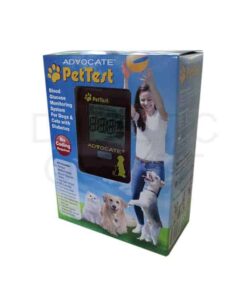Diabetes Learning Center, Pet Diabetes & Health, Pet Diabetes Supplies
WHY USE A PET-SPECIFIC GLUCOSE METER?
Effective glucose monitoring is the key to proper management of diabetes in cats and dogs. Although glucose levels in diabetic cats and dogs can be measured using the same techniques used in humans, the meter used for measuring their blood glucose levels would have to be the one that is specifically made for cats and dogs. A human glucose meter, when used for measuring glucose levels in cats and dogs, can often deliver inaccurate results.
The human home glucose monitoring systems are being increasingly used for pet diabetes management, yet many pet owners may not know that glucose readings obtained from a pet using a human meter may not be as precise as the ones obtained from a pet specific meter. Fortunately, the developments and availability of pet specific glucose meters have made obtaining accurate glucose readings for cats and dogs at home a possibility that did not exist a decade ago.
Why human meters are not as accurate as pet specific meters?
The reason behind why human meters do not deliver accurate glucose readings for pets is due to the difference between the distribution of glucose in the blood of humans and animals.
Humans: 58% of the glucose is located in plasma and 42% of the glucose in the red blood cells.
Dogs: 87.5% of the glucose is located in plasma and 12.5% of the glucose in the red blood cells
Cats: 93% of the glucose is located in plasma and only 7% of the glucose in the red blood cells.
As you can see the distribution of glucose in the blood of humans and animal is different. There is also a definite variation between the size of the red blood cells between humans and animals. Even more, humans and pets have a different PCV (packed cell volume) – humans: 37-50%, dog: 37-55%, cat: 24-45%, meaning that the number of red blood cells differs a lot between the species.
For these reasons, the glucose readings from a human blood glucose meter and one created specifically for animals are going to be different. Meters made for humans are calibrated for human plasma, therefore providing accurate results, while meters made for cats and dogs are calibrated for pet plasma.
To obtain accurate glucose readings for your cats and dogs you must use a glucose meter specifically calibrated for pets. Using a human glucose meter for measuring glucose levels in cats and dogs can deliver inaccurate results that are often significantly lower than what they actually are.




Is cat and dog’s glucose meter can use for rabbits too?
We would recommend asking the manufacturer that question.
Isnt there a formula or a way of calculating the results between the human and pet monitors? If the differences are known, one should be able to calculate the results. But of course, the manufacturers are not going to share that secret.
After 2 years of research and testing with 3 AT meters on same blood gtt ..and different strip manufacturers, I can make no sense out most of the compared results. Because animals are still considered “property”, it makes me wonder if we are all been “had” by Abbott, Zoetis, Petsure, etc…To date, I cannot get a consistent technological or expert explanation re:the strips or meters that matches the BG results..And the various explanations from Abbott and then Zoetis for “coding” do not match the blood properties explained above. I am not willing to (yet) use a human meter with human strips but many do..At least they know what to expect. I will continue to explore my expectations with the manufacturers …but frustration and going “broke” will most likely continue for me. I am tired of hearing, “Well, each dog is unique.” since we are paying much more for AT strips than others pay for “human” strips.
Thank you for sharing your feedback. I am sorry about your bad experience with blood glucose monitors. May I suggest you try the Advocate PetTest blood glucose monitor specifically designed for pets? We have never had any complaints about this monitor.
I don’t know why they can charge so much more for strips… you have strips for a human ADVOCATE reader that are 6.00 and the strips for the Pet Advocate are $37 – $40. Ridiculous and unnecessary … if you have a vet that can tell you the difference and you can use a human one by all means if cost is a factor do it. I have 2 different pet meters that show me 2 different readings .. plus a regular human meter … I just take a reading from the advocate pet and the relion and figure the difference … it is pathetic that manufacturers of the “pet” strips are robbing pet lovers blind. Just pathetic.
I agree, 100%! There is no excuse for such a markup and then for them to not work correctly or even the same? It seems to me the manufacturers see their pet market as a boondoggle that doesn’t require the same rigorous standards as the human market, but they can use to con three times the money from owners to fund their company’s other endeavors. We pet owners need our own lobbyist.
I really need a glucose machine for my dog
You can order one here: https://diabeticoutlet.com/product/advocate-pettest-glucose-meter-kit/ free same day shipping!
I compared over several days a human glucometer reading, a Alpharetta 2 glucometer and a freestyle libre on my pug the human and alpha track were always close. I believe its marketing bull****
Perhaps dogs and cats are different. My freestyle libre on my cat kept reading LO (below 40) scaring me into thinking my cat was in trouble, I’d do a check with my Alphatrak2 and that reading had him in the 110-120 range each time. My vet had me do a12-hour blood glucose curve (checks every 2 hours) using both glucometers and the difference between the two meters varied from 50 – 90 points on each reading.